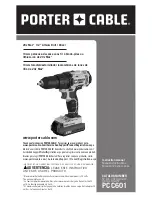
19
T R O U B L E S H OOT I N G
PROBLEM
PROBABLE CAUSE
REMEDY
Noisy
operation
(under load).
a.
Incorrect belt tension.
b.
Dry spindle.
c.
Loose pulley.
d.
Loose belt.
e.
Worn bearing.
a.
Adjust tension.
b.
Remove spindle and quill
assembly and lubricate.
c.
Tighten pulley.
d.
Adjust belt tension.
e.
Replace bearing.
Excessive drill
wobble.
a.
Loose chuck.
b.
Worn spindle or bearing.
c.
Worn chuck.
d.
Bent drill bit.
a.
Tighten by pressing chuck down
on to a block of wood against
the table.
b.
Replace spindle shaft or bearing.
c.
Replace chuck.
d.
Renew drill bit.
Motor won’t
start.
a.
Power supply.
b.
Motor connection.
c.
Switch connection faulty.
d.
Faulty switch.
e.
Motor windings burned.
f.
Pulley cover not closed.
g.
Micro switch on cover
not operating.***
a.
Check power cord/fuse.
b.
Check motor connections.
c.
Check switch connections.
d.
Replace switch.
e.
Replace motor.
f.
Close pulley cover.
g.
Check operation of micro switch,
and renew/adjust as necessary.
Drill binds in
workpiece.
a.
Excessive feed pressure.
b.
Loose belt.
c.
Loose drill.
d.
Incorrect bit speed.
e.
Drill angles incorrect
for type of material.
a.
Apply less pressure.
b.
Check belt tension.
c.
Tighten drill with key.
d.
Adjust the drill speed
reasonably.
e.
Consult a technical manual
dealing with materials, drills and
cutting angles, and sharpen drill
accordingly.
Drill bit burns
or smokes.
a. Incorrect speed.
b. Swarf isnt discharging.
c.
Dull drill or not proper.
clearance for material.
d.
Needs coolant.
e.
Excessive feed pressure
a.
Adjust drill speed accordingly.
b.
Clean drill.
c.
Check sharpness & taper.
d.
Use coolant whilst drilling.
e.
Apply less pressure.
Table di
ffi
cult
to raise.
a.
Needs lubrication.
b.
Table lock tightened.
a.
Lubricate with light oil.
b.
Loosen clamp.



































